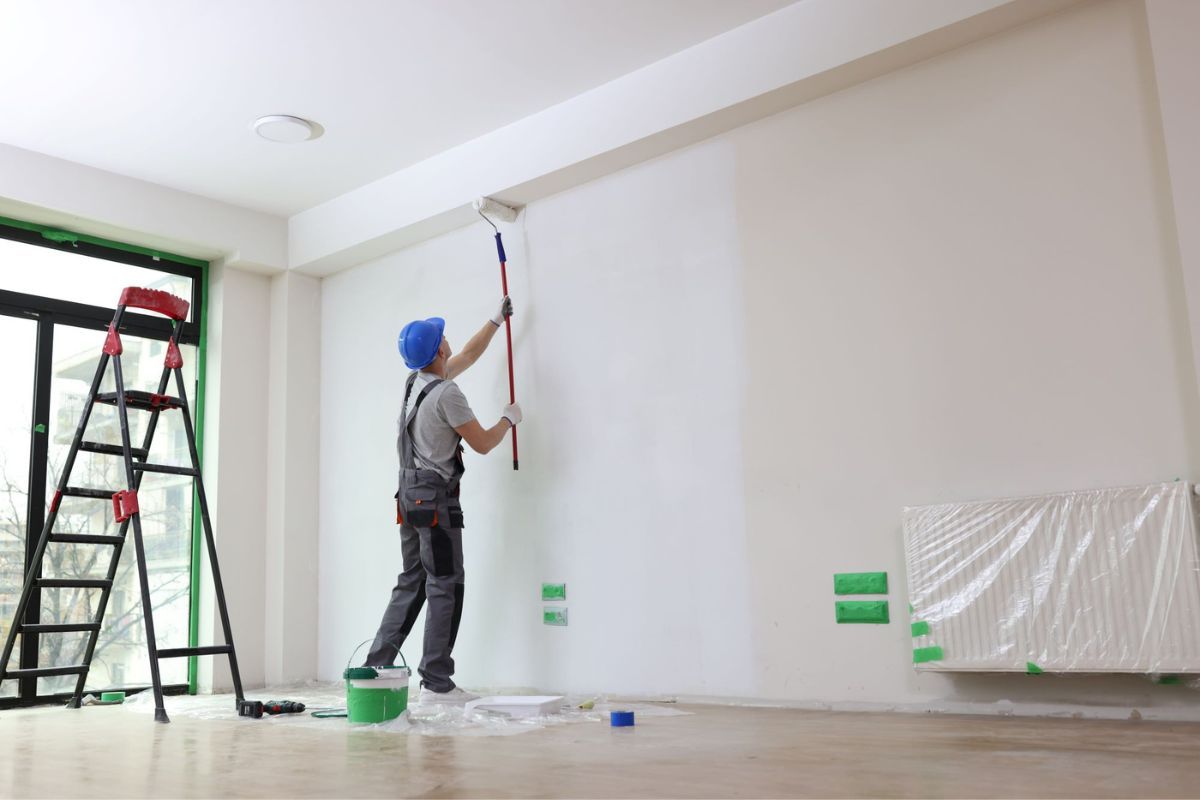As the seasons change, your home needs to adapt. This is particularly true when it comes to maintaining and updating paintwork.
Whether it’s the intense sun of summer or the harsh cold of winter, weather conditions have a significant impact on the surfaces of your home, both inside and out.
Consequently, painting your home, whether for protection, aesthetic refreshment, or property value enhancement, requires strategic planning and consideration of seasonal factors.
Many homeowners may not realize that the season in which they choose to paint can influence the final outcome of their efforts.
From temperature fluctuations to humidity levels, the environment affects how paint adheres, dries, and endures.
Harnessing the right seasonal cues can enhance the paint’s longevity and appearance, while ignoring them may result in premature cracking, blistering, or fading.
Table of Contents
Choosing the Right Time to Paint: Summer vs. Winter
Timing is everything with exterior and interior painting.
Each season has its own advantages and limitations, and choosing the best time to undertake a painting project can mean fewer complications and better results.
Summer is typically associated with better weather conditions, making it the preferred season for many painting projects.
Paint tends to dry faster, and longer daylight hours provide more working time. However, specific considerations, like avoiding very hot days or direct sunlight, are still vital.
Winter, particularly in milder climates, shouldn’t be dismissed outright.
While traditional wisdom may steer people away from winter painting, modern advancements in paint technology have made it possible to work in lower temperatures.
However, painters still need to be cautious of extreme cold and high humidity, which can affect drying times and overall finish quality.
Preparing Your Home for Cold Weather Painting
If you’re planning to paint during the colder months, preparation becomes even more critical.
Begin by thoroughly inspecting your home’s exterior for signs of damage that the cold could worsen.
Cracks, peeling paint, rotting wood and any previously water-damaged sections should be repaired before painting begins.
- Related article: How to Fix Peeling Paint on the Exterior of a House?
For both DIY enthusiasts and professionals, it’s important to use paints designed for low-temperature application.
These are formulated to adhere and cure properly in conditions that might stifle traditional paints.
Check the paint can label or consult with your local paint supplier for temperature requirements; many paints will not cure correctly if the temperature is below 41 ºF.
You should also monitor weather forecasts carefully.
Aim to begin painting on a day where both daytime and nighttime temperatures are within the paint’s recommended application range and will remain stable for at least 48 hours.
Temperature swings can create condensation, which interferes with drying.
Moisture is another critical concern. Surfaces must be completely dry before painting.
In colder months, dew lingers longer and precipitation is more frequent, which means you may need to wait longer than expected before starting.
Power washing prior to painting must be scheduled meticulously to ensure enough time for drying.
Choosing Paint Colors in Winter
The lighting in winter is quite different from that in summer.
During winter months, the natural light tends to be cooler and greyer, which can substantially alter how a color looks on your walls.
Before committing to a full re-coat, test your chosen shades by applying samples to small sections of walls and observing them at different times of the day under various lighting conditions.
For interiors, many homeowners gravitate towards warmer and richer colors when painting in winter.
These hues can create a sense of warmth and comfort, making indoor spaces feel more inviting during long, darker days.
Earthy tones, deep blues, and forest greens are popular choices, complementing the winter ambiance while adding a touch of cosiness.
Optimal Techniques for Interior Painting in Cold Months
Painting the interior of your home during winter offers fewer logistical challenges compared to exterior work, although some unique considerations still apply.
Cold weather often means closed windows and reduced ventilation, which can extend drying times and increase paint odor.
To mitigate this, use low-VOC (volatile organic compounds) or odor-free paints.
These environmentally conscious options are better for indoor air quality and safe to use in poorly ventilated spaces.
Additionally, introduce fans or air purifiers to circulate air and reduce lingering fumes.
Ensure your indoor heating system is working effectively and consistently during the painting process.
Sudden temperature drops overnight can affect drying and lead to flash drying, where the surface dries faster than the underneath layers, which can affect the finish.
Another insider tip is to avoid overloading your brush or roller.
Thicker coats take much longer to dry in winter, and multiple thin coats will yield a more polished and durable result.
- Related article: Expert Advice for Interior Painting Success in Virginia
Summer Preparation for Exterior Painting
Summer is often considered the ideal season for house painting, especially for exterior surfaces.
Warm, dry days and less rainfall make it an attractive window for home improvement. However, this doesn’t mean you can neglect preparation.
Start by cleaning surfaces thoroughly with a pressure washer to remove accumulated dirt, mildew, and old flaking paint.
The hot summer sun can bake in impurities if not removed efficiently.
After pressure washing, allow a couple of days for surfaces to dry completely, depending on humidity levels.
Conduct a full examination of the exterior, looking for signs of sun damage or cracking, particularly on walls that face direct sunlight.
The UV rays can be harsh on certain materials, especially wood and older layers of paint. Repair and prime damaged areas before applying the new coat.
Plan to paint in the early morning or late afternoon to avoid the hottest times of the day.
Painting in direct sunlight can cause paint to dry too quickly, compromising its ability to bond properly. This may result in blistering or uneven streaks in the finish.
- You should also read: 7 Common Causes Of Exterior Paint Problems
Selecting Paint Resistant to Sun Damage
Not all paints are created equal when it comes to resisting UV rays and heat.
When prepping for summer applications, select high-quality exterior paints with built-in UV resistance and fade protection.
Many manufacturers offer lines of paint specifically formulated to withstand the summer elements.
While color selection should reflect your aesthetic preference, consider the functional traits of your chosen hues.
Dark colors absorb more heat, potentially causing expansion and contraction of underlying surfaces, leading to cracking over time.
Lighter colors reflect sunlight more effectively, keeping the surface cooler and potentially extending the life of your paint job.
Capturing Summer Light Indoors
Interior summer painting presents an excellent opportunity to rejuvenate spaces with colors that maximize the influx of natural light.
Opt for airy shades like pastels, light greys, and whites to make rooms feel more spacious and cooler. These colors reflect sunlight and help regulate indoor temperatures naturally.
Before painting, assess any seasonal damage such as chipped walls around window panes or moisture marks caused by increased summer humidity.
Sand and prime those spots carefully before painting.
You’ll also need to address areas that may show early signs of mold growth due to excess humidity, especially in kitchens or bathrooms.
With longer daylight hours, summer provides ample working time. Still, be mindful of intense interior temperatures.
Apply paint early in the day when indoor spaces haven’t yet heated up significantly. This slows the drying process slightly, allowing the coat to settle more evenly.
Painting and Home Value Considerations All Year Round
Regardless of season, a well-painted home significantly influences curb appeal and overall property value.
A neat and updated exterior suggests care and attention, attracting buyers and improving neighborhood aesthetics.
Seasonal painting can also serve as preventative maintenance. Paint acts as a protective barrier against the weather.
For example, in winter-prone regions, a fresh, high-quality exterior coat can prevent moisture absorption that causes wood rot and internal leaks.
In sunnier climates, UV-resistant paint preserves structural integrity.
Painting becomes not just cosmetic enhancement but also a way to protect your investment.
Hiring Professional Painters: When to Bring in Help
While many homeowners might take on painting projects themselves, seasonal painting often benefits from the expertise of professionals.
Experienced Virginia painters understand the nuances of weather-driven variables and can deliver better, longer-lasting results with less hassle.
They also know how to plan around unpredictable weather patterns and have access to commercial-grade materials that might be inaccessible to average consumers.
Many professional painters also offer seasonal discounts or guaranteed scheduling in off-peak months like late autumn or early spring.
If your project involves a large exterior façade, multi-storey work, or complex detailing, hiring professionals like Benjamin Painters in Virginia can also be a safer option.
They bring necessary equipment like scaffolding and ladders, ensuring the job is done efficiently and securely.
Taking the Next Step
Whether you’re bracing for snow or preparing for heat waves, seasonal painting is an essential part of responsible home maintenance.
By understanding the unique challenges and opportunities each season presents, you can make informed decisions that lead to a more durable, beautiful, and energy-efficient home.
In Summary
Seasonal painting isn’t just about timing, it’s about strategy.
From selecting the right paints and colors to understanding weather impacts and prepping properly, aligning your painting efforts with seasonal conditions ensures better outcomes and longer-lasting results.
Whether you’re refreshing interiors during the winter or giving your home’s exterior a summer glow-up, thoughtful planning and execution can make all the difference.
If in doubt, contact Benjamin Painters to ensure your home not only looks its best, but stays protected, year-round.



0 Comments